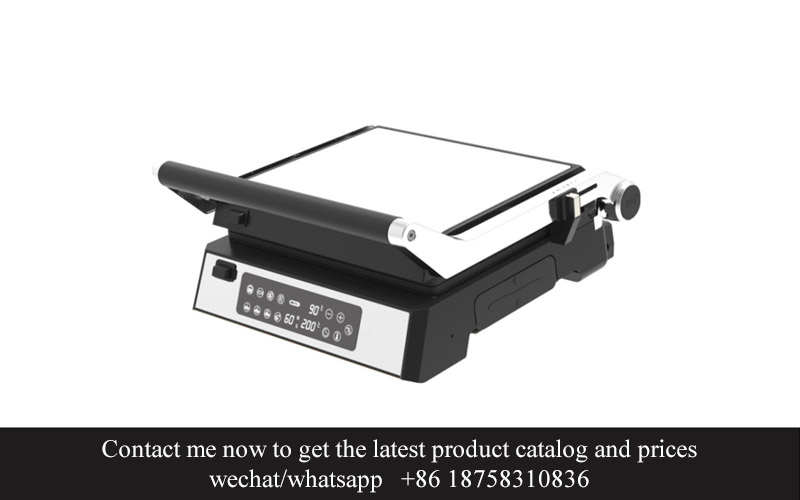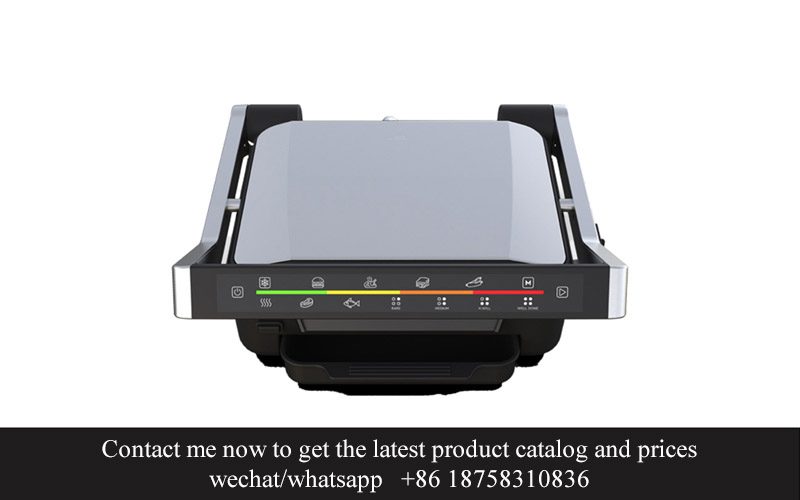Address
304 North Cardinal
St. Dorchester Center, MA 02124
Work Hours
Monday to Friday: 7AM - 7PM
Weekend: 10AM - 5PM
Address
304 North Cardinal
St. Dorchester Center, MA 02124
Work Hours
Monday to Friday: 7AM - 7PM
Weekend: 10AM - 5PM

In the ever-evolving world of kitchenware, where technology meets daily necessity, we find ourselves at the precipice of exciting innovations and advancements. The kitchen, once a realm of simple cookware and appliances, has transformed into a hub of smart solutions and cutting-edge designs. This shift is not just a matter of aesthetics but also functionality, sustainability, and ethical manufacturing practices. As we delve into the heart of this dynamic industry, it becomes clear that embracing innovation and quality is not just a choice but a necessity for the future of kitchenware.
The European and American markets have witnessed a remarkable surge in the demand for kitchenware in recent years. This boom can be attributed to several factors, each contributing to the growing popularity and necessity of high-quality kitchen gadgets and appliances.
Gone are the days when kitchenware was merely a utilitarian necessity. Today, it’s a reflection of personal style, culinary aspirations, and the pursuit of convenience. Consumers in these regions are increasingly seeking innovative and efficient kitchen solutions that not only enhance their cooking experience but also add a touch of sophistication to their homes.
One of the key drivers behind this rise is the shift towards health-conscious living. With a growing number of people embracing home cooking, there’s a heightened focus on kitchenware that promotes healthy eating habits. From eco-friendly cookware to appliances that help track nutritional content, the market is responding to these demands with a plethora of options.
Moreover, the integration of technology into kitchenware has opened up new horizons. Smart kitchen gadgets that can connect to smartphones and tablets are becoming increasingly popular. These devices not only simplify tasks but also provide valuable insights into cooking techniques and recipes. The tech-savvy consumer is driving the demand for such advanced kitchenware, pushing manufacturers to innovate and create cutting-edge products.
The rise of gourmet cooking and the culinary arts has also played a significant role in shaping the kitchenware market. Professional-grade appliances that once belonged exclusively to chefs are now finding their way into the average household. Induction cooktops, high-end blenders, and professional-grade mixers are just a few examples of how the professional kitchen has influenced the consumer market.
In addition to technological advancements and health trends, the kitchenware industry is being propelled by a strong emphasis on sustainability. Consumers are more aware than ever of the environmental impact of their purchases, and they’re seeking out products that are made from sustainable materials and produced in an eco-friendly manner. This shift has led to the emergence of a new category of kitchenware that is not only functional but also planet-friendly.
Another factor contributing to the rise of kitchenware in the European and American markets is the changing demographics. The increasing number of single-person households and busy professionals looking for time-saving solutions has created a market for compact and versatile kitchenware. This demographic is looking for appliances that can multitask and simplify their daily cooking routines.
The retail landscape is also evolving, with a greater emphasis on online sales and the rise of e-commerce platforms. Consumers are now able to access a wider variety of kitchenware products from the comfort of their homes, often at competitive prices. This ease of access has further fueled the demand for innovative and high-quality kitchenware.
Brands that have capitalized on these trends have seen substantial growth. They have managed to combine style, functionality, and sustainability in their product lines, catering to the diverse needs of today’s consumers. From high-end brands that cater to the gourmet market to budget-friendly options that appeal to the masses, the kitchenware industry is thriving.
In conclusion, the rise of kitchenware in the European and American markets is a multifaceted phenomenon driven by health trends, technological advancements, culinary culture, sustainability concerns, and changing consumer demographics. As the industry continues to evolve, we can expect to see even more innovative products that not only enhance our cooking experiences but also reflect our values and aspirations.

BSCI audited factories have become a beacon of quality and ethical manufacturing in the global market, particularly within the kitchenware industry. These factories are certified by the Business Social Compliance Initiative (BSCI), an initiative founded by German retailers in 2003 to address social compliance issues in the supply chain. Here’s a closer look at what it means to be BSCI audited and the impact it has on kitchenware production.
The BSCI audit process is comprehensive, encompassing a thorough assessment of working conditions, labor rights, and environmental practices. Factories that pass this audit are committed to upholding the BSCI’s 11 Principles, which range from the right to freedom of association and collective bargaining to the provision of safe working conditions and the elimination of child labor.
One of the key aspects of BSCI certification is the focus on labor rights. Audited factories must ensure that workers are treated fairly and that their rights are respected. This includes providing fair wages, a safe working environment, and reasonable working hours. In the kitchenware industry, where precision and detail are paramount, maintaining a workforce that is motivated and well-treated is crucial for producing high-quality products.
Environmental responsibility is another cornerstone of the BSCI standards. Factories must demonstrate their commitment to reducing their ecological footprint by managing waste, conserving resources, and using sustainable materials. For kitchenware manufacturers, this means sourcing materials that are not only durable but also environmentally friendly, contributing to a greener planet.
The audit process itself is rigorous. It involves an on-site inspection by a BSCI-certified auditor who examines all aspects of the factory’s operations. This includes interviews with workers, a review of employment contracts, and an assessment of the factory’s health and safety measures. The auditor also looks at the factory’s management systems to ensure they are in place and functioning effectively.
For kitchenware products, the BSCI audit can mean the difference between a product that is simply made and one that is crafted with a conscience. It ensures that the materials used are sourced ethically and that the production process adheres to strict environmental and social standards. This not only benefits the workers and the environment but also builds trust with consumers who are increasingly seeking out products that align with their values.
One of the notable features of BSCI audited factories is their focus on continuous improvement. They are required to develop and implement action plans to address any issues found during the audit. This means that over time, these factories become more efficient and more socially responsible, leading to better products and a stronger market presence.
The impact of BSCI certification on kitchenware can be seen in several ways. Firstly, it helps to reduce the risk of ethical scandals that can tarnish a brand’s reputation. Consumers are more likely to purchase from brands that are transparent about their supply chain and manufacturing practices.
Secondly, BSCI audited factories often have better-trained employees. This translates into higher quality products, as workers are more skilled and motivated. In the kitchenware industry, this can mean the difference between a product that lasts a lifetime and one that falls apart after a few uses.
Thirdly, the BSCI standards encourage innovation. Factories are motivated to find new ways to improve their operations, which can lead to the development of cutting-edge kitchenware products that are not only functional but also sustainable.
In conclusion, BSCI audited factories in the kitchenware industry are a testament to the commitment to ethical manufacturing and social responsibility. They provide consumers with a sense of security, knowing that the products they purchase are made with care for both the workers and the environment. As the market continues to evolve, the role of BSCI audited factories is likely to grow, ensuring that the kitchenware industry remains at the forefront of quality and sustainability.

In the ever-evolving landscape of kitchenware, innovation is the driving force behind the creation of products that not only enhance the cooking experience but also seamlessly integrate into modern lifestyles. From smart appliances to eco-friendly utensils, the future of kitchenware is marked by a blend of technology, sustainability, and user-centric design.
The rise of smart kitchen gadgets has revolutionized the way we interact with our cooking tools. Imagine a set of kitchen knives that automatically sharpen themselves, or a refrigerator that analyzes your dietary needs and suggests recipes. These devices are not just about convenience; they’re about making cooking a more enjoyable and efficient process. The integration of AI and IoT (Internet of Things) technology into kitchenware is setting new standards for user experience.
Eco-conscious consumers are increasingly seeking out kitchenware that aligns with their environmental values. Biodegradable cutting boards, stainless steel straws, and reusable silicone containers are just a few examples of sustainable products gaining popularity. These items not only reduce waste but also offer long-lasting solutions that are gentle on the planet.
Interactive kitchenware is another area where innovation is taking root. Imagine a countertop that displays cooking times and temperatures, or a set of cookware that communicates with your smartphone to provide cooking instructions. These advancements are not just about adding a new feature; they’re about creating a more intuitive and connected kitchen environment.
Personalization is also a key trend in kitchenware innovation. Customizable bakeware, personalized kitchen gadgets, and even cookbooks that adapt to your skill level are becoming more common. This shift acknowledges that every cook has unique preferences and needs, and the best kitchenware should cater to those individual tastes.
Functionality meets fashion in the world of modern kitchenware. Designers are pushing the boundaries of what kitchenware can look like, with sleek, minimalist designs that appeal to both the eye and the eco-conscious consumer. The use of high-quality materials like copper, ceramic, and glass is not only practical but also aesthetically pleasing, making kitchenware a centerpiece of the kitchen decor.
In the realm of cooking utensils, there’s a growing emphasis on ergonomics and comfort. Tools with ergonomic handles, non-slip bases, and innovative shapes are designed to reduce strain and improve control. These thoughtful designs make cooking less of a chore and more of a pleasure, especially for those who spend hours in the kitchen.
Safety is another critical aspect of kitchenware innovation. Non-toxic coatings, heat-resistant materials, and anti-slip surfaces are becoming standard features, ensuring that kitchenware is not only stylish and functional but also safe to use. The focus on safety is particularly important as more families are cooking at home, often with children present.
The rise of social media and online communities has also influenced kitchenware innovation. Influencers and home cooks are sharing their experiences and preferences, which in turn influences manufacturers to develop products that cater to these trends. From viral TikTok trends to Instagram-worthy recipes, the kitchenware industry is responding to the changing demands of its consumers.
In conclusion, the future of kitchenware is bright and filled with possibilities. As technology continues to advance and consumer preferences shift, we can expect to see even more innovative products that make cooking easier, more enjoyable, and more sustainable. The kitchenware of tomorrow will not only be a reflection of our culinary skills but also a testament to our commitment to living a more connected and eco-friendly life.

In the ever-evolving world of kitchenware, staying ahead of the curve is key. Here’s a look at some of the latest trends that are heating up the market:
Smart Technology IntegrationModern kitchenware is no longer just about function; it’s about connectivity. Smart appliances that can be controlled via smartphones or voice assistants are becoming increasingly popular. From smart ovens that can be preheated remotely to refrigerators that track your groceries, technology is making its mark in the kitchenware industry.
Eco-Friendly and Sustainable MaterialsWith growing environmental concerns, there’s a significant shift towards eco-friendly kitchenware. Consumers are gravitating towards products made from sustainable materials like bamboo, recycled stainless steel, and biodegradable plastics. These materials not only reduce the carbon footprint but also offer a stylish and durable alternative to traditional options.
Minimalist Design AestheticsMinimalism has taken over the kitchenware market, with sleek, clean lines and a focus on simplicity. Minimalist designs often come in neutral colors like white, black, and gray, and they emphasize the beauty of the product itself rather than the embellishments. This trend is appealing to those who prefer a clutter-free kitchen space and a more refined aesthetic.
Health and Wellness-Oriented ProductsAs health consciousness grows, kitchenware that promotes wellness is on the rise. Products like non-toxic cookware, air-fryers that reduce oil usage, and kitchen gadgets that help in meal prep are becoming more sought after. These items cater to consumers looking to improve their diet and overall well-being.
Multifunctionality and Space-Saving SolutionsIn today’s fast-paced world, kitchenware that can do more with less is a hit. Multifunctional gadgets like multi-purpose blenders, pressure cookers that can also sauté, and expandable storage containers are popular for their ability to save time and space. These products are perfect for small kitchens or for those who love to simplify their cooking process.
Customization and PersonalizationThe market is seeing a rise in customizable kitchenware. Consumers are looking for products that they can personalize with their own touch, whether it’s through monogramming, custom colors, or unique designs. This trend reflects a desire for individuality and a kitchen that reflects one’s personality.
Interactive and Educational ToolsInteractive kitchenware that teaches or encourages learning is gaining traction. From digital scales that help you measure ingredients with precision to cookbooks with built-in recipe cards, these tools are designed to make cooking more engaging and accessible for all skill levels.
Sustainability and Ethical SourcingConsumers are not just looking for sustainable materials but also for products that are ethically sourced. Kitchenware brands that can demonstrate a commitment to fair trade, responsible manufacturing, and transparent supply chains are winning over customers who care about the social impact of their purchases.
Innovative Cooking TechniquesThe rise of unique cooking techniques is influencing kitchenware trends. From sous-vide devices that allow for precise temperature control to induction cooktops that offer faster and more energy-efficient cooking, these tools are enabling home chefs to experiment with new and exciting culinary methods.
Urban and Urban-Inspired DesignsUrban living has influenced the kitchenware market, with a growing number of products inspired by city life. Urban-inspired designs often feature bold colors, geometric shapes, and modern aesthetics that appeal to those who live in urban environments or appreciate a cityscape aesthetic.
In conclusion, the kitchenware market is buzzing with innovation and consumer demands. From smart technology to eco-conscious materials and personalized designs, the trends reflect a market that is both forward-thinking and responsive to the evolving needs of its customers.

In today’s fast-paced and health-conscious world, the significance of quality assurance in kitchenware cannot be overstated. From the materials used to the manufacturing processes and final product testing, every step plays a crucial role in ensuring that consumers receive not just a kitchen tool, but a reliable and safe companion for their culinary endeavors. Here’s a deeper look into why quality assurance is paramount in the kitchenware industry.
The foundation of quality assurance lies in the choice of materials. High-quality kitchenware is often crafted from premium materials such as stainless steel, which is not only durable but also resistant to corrosion and heat. By selecting the right materials, manufacturers set the stage for a product that can withstand the rigors of daily use.
Functionality is another key aspect where quality assurance shines. Modern kitchenware designs are not just about aesthetics; they are about making cooking easier and more efficient. Features like non-stick coatings, ergonomic handles, and innovative shapes are all the result of meticulous design and testing. These features not only enhance the user experience but also contribute to the longevity of the product.
Safety is a non-negotiable factor in kitchenware. Quality assurance protocols ensure that products are free from harmful substances such as lead and BPA. Regular safety checks and certifications like the FDA approval process guarantee that kitchenware is safe for both the cook and the consumer, especially when it comes into contact with food.
Durability is a testament to the effectiveness of quality assurance. Longevity in kitchenware is achieved through robust construction and high-quality manufacturing processes. When a product can withstand heavy use without showing signs of wear and tear, it’s a clear sign that quality control measures were rigorously applied.
Consistency in quality is achieved through stringent quality control checks at every stage of production. From raw materials inspection to the final product assembly, each item is scrutinized to ensure it meets the manufacturer’s standards. This attention to detail minimizes defects and ensures that every piece of kitchenware leaving the factory is up to par.
Customer satisfaction is directly linked to the quality of kitchenware. When consumers purchase a product that performs as advertised and stands the test of time, they are more likely to trust the brand and recommend it to others. Quality assurance, therefore, becomes a tool for building brand loyalty and reputation.
Environmental considerations are also part of quality assurance in kitchenware. Eco-friendly materials and sustainable manufacturing practices are becoming increasingly important. By choosing environmentally responsible options, manufacturers not only reduce their carbon footprint but also appeal to consumers who are conscious of their ecological impact.
Innovation in kitchenware is driven by quality assurance. As manufacturers push the boundaries of what’s possible, they rely on rigorous testing to validate new designs and technologies. This ensures that the latest trends in kitchenware are not only exciting but also practical and reliable.
Lastly, the global market demands compliance with various standards and certifications. Quality assurance helps kitchenware brands navigate these complexities, ensuring that their products adhere to international regulations. This compliance is essential for exporting and expanding into new markets.
In conclusion, the significance of quality assurance in kitchenware is multifaceted. It encompasses material selection, functionality, safety, durability, consistency, customer satisfaction, environmental responsibility, innovation, and global compliance. By prioritizing quality, kitchenware manufacturers not only deliver a product that meets consumer expectations but also contribute to the overall trust and success of the industry.

In the ever-evolving landscape of kitchenware, the introduction of BSCI audited factory products has sparked a revolution. These products are not just items for the kitchen; they’re a testament to a new era of quality, safety, and sustainability. Let’s delve into why BSCI audited factory kitchenware is a game-changer.
Traditional kitchenware often comes with a host of concerns, from the materials used to the manufacturing processes. BSCI audited factories, on the other hand, adhere to stringent standards that ensure every product is not just functional but also safe for use. This audit process scrutinizes everything from labor conditions to environmental impact, making these factories a beacon of excellence in the industry.
The audit itself is comprehensive, covering areas such as child labor, forced labor, health and safety, and environmental management. This means that when you pick up a piece of kitchenware from a BSCI audited factory, you’re not just getting a product; you’re investing in a commitment to ethical practices. It’s a shift from simply producing goods to creating a legacy of responsibility.
One of the most significant impacts of BSCI audited factory kitchenware is the emphasis on sustainability. These factories are required to minimize their environmental footprint, from the sourcing of raw materials to the disposal of waste. This commitment to eco-friendliness resonates with consumers who are increasingly conscious of their carbon footprint and the impact of their purchases on the planet.
In terms of design, BSCI audited kitchenware is leading the charge with innovative and user-friendly solutions. From smart appliances that can be controlled via smartphone apps to kitchenware that’s designed for ease of cleaning and durability, these products are not just stylish but also practical. The integration of technology into kitchenware is a trend that’s gaining momentum, and BSCI audited factories are at the forefront of this transformation.
The quality of materials used in BSCI audited factory kitchenware is another aspect that sets it apart. High-grade stainless steel, ceramic, and glass are just a few examples of materials that are meticulously selected for their durability and safety. This focus on quality ensures that the kitchenware is not only beautiful to look at but also long-lasting, offering consumers peace of mind.
The impact of BSCI audited factory kitchenware extends beyond the product itself. It influences the supply chain, pushing other manufacturers to raise their standards. This ripple effect is crucial in an industry where transparency and accountability are becoming more important than ever.
Moreover, BSCI audited factory kitchenware is changing the way consumers view their purchases. It’s not just about acquiring items; it’s about making a statement. By choosing BSCI certified products, consumers are voting for ethical manufacturing and responsible consumption. This shift in mindset is powerful and has the potential to drive significant change in the industry.
In the realm of health and safety, BSCI audited kitchenware is a game-changer. The rigorous standards ensure that products are free from harmful substances, reducing the risk of health issues associated with low-quality kitchenware. This is particularly important in a world where food safety is a top priority for many consumers.
The versatility of BSCI audited factory kitchenware is also noteworthy. Whether it’s a sleek knife set for the professional chef or a simple set of dishes for the home cook, these products cater to a wide range of needs. The diversity in design and functionality means that there’s something for everyone, making BSCI audited kitchenware accessible to all.
The global nature of the kitchenware market is another area where BSCI audited factory products are making a difference. By setting a high bar for international standards, these factories are fostering a more cohesive and reliable global supply chain. This is especially crucial in the face of global challenges such as trade disputes and economic instability.
In conclusion, BSCI audited factory kitchenware is a game-changer because it embodies a new era of responsible manufacturing. From ethical labor practices to sustainable materials and cutting-edge design, these products are reshaping the industry. As consumers become more discerning about where and how their products are made, BSCI audited kitchenware is leading the charge towards a brighter, more sustainable future.

BSCI certification is more than just a stamp of approval; it’s a promise of quality, ethical manufacturing, and consumer safety. This global initiative has become a benchmark for businesses in the kitchenware industry, and its impact on consumers is profound.
In a market where the competition is fierce and products are abundant, the BSCI certification serves as a beacon of trust. It assures consumers that the kitchenware they purchase has been produced under strict standards that prioritize fair labor practices, environmental responsibility, and health and safety measures. Let’s delve into the various benefits that BSCI certification brings to consumers.
Ethical Labor PracticesThe BSCI audit process requires factories to adhere to a code of labor practices that includes the abolition of forced labor, freedom of association, and the right to collective bargaining. For consumers, this means they are supporting products that come from places where workers are treated with respect and dignity. By choosing BSCI-certified kitchenware, consumers are directly contributing to a world where labor rights are upheld.
Health and Safety StandardsIn the kitchen, safety is paramount. BSCI audits ensure that kitchenware products meet stringent health and safety regulations. This includes the use of non-toxic materials, proper labeling, and adherence to hygiene standards during production. Consumers can feel confident that their kitchenware is not only functional but also safe for their families and the environment.
Environmental ResponsibilityModern consumers are increasingly aware of the environmental impact of their purchases. BSCI certification requires factories to implement measures that minimize environmental damage, such as reducing waste, using renewable energy, and promoting sustainable practices. When consumers buy kitchenware with BSCI certification, they’re also investing in a more sustainable future.
Transparency and TraceabilityOne of the standout features of BSCI certification is its focus on transparency. The audit process involves regular inspections and requires factories to provide detailed information about their supply chain. This level of traceability gives consumers peace of mind, knowing exactly where their products come from and how they were made.
Quality AssuranceThe quality of kitchenware can vary widely, and it’s not always easy for consumers to discern which products are worth their investment. BSCI certification acts as a quality assurance mark. It signifies that the product has been manufactured in a facility that has undergone a thorough review, ensuring that the end product meets high standards.
Longevity of ProductsProducts that are BSCI-certified are often designed to last longer. The rigorous quality checks ensure that materials are durable and that manufacturing processes are reliable. This means that consumers are not just getting a product that meets their immediate needs but one that will serve them well over time.
Community DevelopmentBSCI audits also encourage factories to contribute to the communities where they operate. This can include supporting local schools, providing healthcare, and promoting education and training programs. By purchasing BSCI-certified kitchenware, consumers are indirectly supporting these initiatives and helping to improve the lives of those in the communities where the products are made.
Global RecognitionBSCI certification is recognized internationally, which means that consumers can trust the label regardless of where they are located. This global standard ensures that the benefits extend beyond a single region, reaching consumers around the world.
Financial SecurityFor consumers, the BSCI certification also offers financial security. In the unlikely event that a BSCI-certified product causes harm due to a manufacturing defect, the certification often comes with a warranty or recall process that protects the consumer’s investment.
In summary, BSCI certification matters to consumers because it represents a commitment to ethical practices, health and safety, environmental stewardship, and quality assurance. It’s a mark that consumers can look to when they want to make a purchase that aligns with their values and contributes positively to the world around them. Whether it’s a high-tech kitchen appliance or a simple cooking utensil, BSCI certification adds an extra layer of assurance that the product is not just good for the consumer, but good for everyone involved in its creation.

In the realm of kitchenware, there are products that stand out not just for their functionality but for their quality and ethical manufacturing processes. BSCI-audited factories have produced several kitchenware items that have become game-changers in the market. Let’s delve into a few case studies that highlight the success of these products.
One such product is the “Eco-Friendly Blender” from GreenGadgets, a brand known for its commitment to sustainability. This blender, crafted in a BSCI-audited factory, boasts a sleek design and powerful performance, but what sets it apart is its eco-friendly materials and energy-efficient motor. The use of recycled plastics and a long-lasting, energy-saving motor has not only caught the attention of environmentally conscious consumers but also won the brand numerous awards for innovation.
Another standout product is the “SmartCook Pressure Cooker” from SmartKitchens. This pressure cooker, manufactured in a BSCI-audited factory, is a marvel of modern technology. It features an integrated smart app that allows users to control the cooking process remotely, monitor the pressure, and even customize recipes. The safety features, such as an automatic shut-off and temperature control, have made it a favorite among busy professionals and home chefs alike.
The “SilentGlide Knife Block” from PrecisionCut Knives is another product that has made a significant impact. Crafted in a BSCI-audited factory, these knives are renowned for their precision, sharpness, and durability. The unique silent glide mechanism ensures that the blades move smoothly within the block, reducing noise and wear. This kitchen essential has become a staple in many professional kitchens and home kitchens due to its exceptional quality and ergonomic design.
The “HydroClean Frying Pan” by CleanCook is yet another example of a successful kitchenware product from a BSCI-audited factory. This pan is designed with a non-stick coating that is not only safe for health but also incredibly easy to clean. The pan’s innovative hydrophilic surface allows for healthier cooking at lower temperatures, reducing the need for excessive oil. Its durability and performance have made it a top choice for those looking for a high-quality frying pan.
The “SmartOven Pro” by OvenTech is a high-tech oven that has revolutionized the way people cook. Designed and manufactured in a BSCI-audited factory, this oven offers a range of features, including a built-in air fryer, convection cooking, and a programmable interface. Its sleek design and advanced technology have made it a must-have for those who appreciate the fusion of style and functionality in kitchen appliances.
The “EcoKettle” by KettleCraft is a product that has been embraced by eco-conscious consumers. Made in a BSCI-audited factory, this kettle is crafted from recycled materials and features a unique, energy-saving design. It not only serves as a practical kitchen tool but also as a statement of environmental responsibility. Its popularity is a testament to the growing demand for sustainable products in the kitchenware market.
The “SmartMix Blender” from MixMaster has also found its place in the hearts of many consumers. This blender, produced in a BSCI-audited factory, is not just about blending; it’s about creating culinary masterpieces. With its variable speed settings, pulse function, and built-in recipe book, it’s an essential tool for anyone looking to experiment with their cooking. The blender’s durability and versatility have made it a go-to choice for both novices and seasoned chefs.
These case studies of successful kitchenware products from BSCI-audited factories demonstrate the importance of quality assurance and ethical manufacturing. They show that when manufacturers prioritize these aspects, they can create products that not only meet consumer needs but also exceed them, fostering loyalty and trust in the brand. As the kitchenware market continues to evolve, it’s clear that products from factories adhering to high standards will be the ones that truly stand out.

In the ever-evolving world of kitchenware, innovation is the cornerstone of progress. As consumers demand more from their kitchen gadgets, the industry is responding with a wave of new technologies and designs. Here’s a glimpse into what the future might hold for kitchenware, highlighting some of the exciting trends and advancements to anticipate.
Smart IntegrationThe integration of smart technology into kitchenware is no longer a novelty; it’s becoming a standard feature. Imagine a blender that not only crushes ice but also syncs with your phone to suggest recipes based on your ingredients. Smart appliances are learning to anticipate our needs, providing personalized cooking experiences and making meal prep more efficient.
Sustainability FocusWith growing environmental concerns, sustainability is at the forefront of kitchenware design. Manufacturers are turning to eco-friendly materials, such as bamboo, recycled plastics, and compostable silicone. These materials not only reduce the carbon footprint but also offer durable, long-lasting products that resonate with eco-conscious consumers.
Health and WellnessHealth trends have spurred the creation of kitchenware that promotes wellness. From non-toxic cookware that eliminates harmful chemicals to cutting boards made from antibacterial materials, the industry is catering to consumers’ desire for healthier living. There’s a growing interest in kitchenware that simplifies the preparation of homemade, nutritious meals.
Interactive LearningThe future kitchenware will likely include interactive elements that educate and guide users. Imagine a set of measuring cups that provide real-time nutritional information or a pan that teaches you the best cooking techniques. These gadgets aim to empower consumers with knowledge, making cooking more accessible and enjoyable for everyone, regardless of skill level.
Energy EfficiencyEnergy consumption is a major concern, and kitchenware manufacturers are responding by creating appliances that consume less power. Induction cooktops, for example, are more energy-efficient than traditional electric ranges, reducing waste and lowering utility bills. As awareness of climate change grows, energy-saving kitchenware will become increasingly popular.
Personalization and CustomizationCustomization is no longer just for cars and phones. The kitchenware industry is exploring ways to offer personalized products. From cookware that adjusts to different heat levels to kitchen gadgets that can be customized with personal engravings, consumers will have the power to tailor their kitchenware to their specific needs and preferences.
Augmented Reality (AR) and Virtual Reality (VR)AR and VR technologies are poised to revolutionize the kitchenware shopping experience. Imagine using AR to visualize how a new set of knives would look in your kitchen or VR to take a virtual cooking class with a celebrity chef. These technologies could transform the way we interact with kitchenware, making it more engaging and informative.
Artisanal CraftsmanshipWhile mass-produced items remain popular, there’s a growing appreciation for artisanal craftsmanship. Handmade kitchenware, often with unique designs and high-quality materials, is becoming a sought-after commodity. These items are not just tools for cooking but also works of art that add a touch of personality to the home.
Health MonitoringKitchenware isn’t just about cooking; it’s also about health. Devices that monitor food safety, such as temperature-controlled food storage solutions or appliances that alert you to allergens, are becoming more common. These gadgets aim to keep your family safe and healthy in the kitchen.
Connectivity and Remote ControlThe rise of the smart home has made connectivity a key feature in kitchenware. From ovens that can be controlled via smartphone to refrigerators that track your inventory and suggest recipes, the future kitchenware will be more connected than ever. This connectivity will not only make cooking easier but also more convenient.
In conclusion, the future of kitchenware is bright and full of possibilities. As technology continues to advance and consumer needs evolve, we can expect to see a wide array of innovative products that make cooking more enjoyable, efficient, and health-conscious. Whether it’s through smart integration, sustainability, or personalization, the kitchenware industry is shaping up to be an exciting space to watch in the coming years.

In the ever-evolving world of kitchenware, innovation and quality stand as pillars that define the future of culinary tools and appliances. The market is abuzz with new technologies, sustainable materials, and smart features that promise to revolutionize the way we cook and live. Here’s a glimpse into what we can expect as the future of kitchenware unfolds.
The integration of smart technology has already begun to reshape the kitchen landscape. Imagine a world where your oven can adjust its temperature based on the recipe you’re using, or your blender has the ability to connect to your smartphone for personalized settings. These advancements are not just about convenience; they’re about creating a seamless and interactive cooking experience.
Sustainability is another driving force in the kitchenware industry. As consumers become more environmentally conscious, there’s a growing demand for products that are not only functional but also eco-friendly. This shift is leading to the rise of kitchenware made from recycled materials, biodegradable plastics, and sustainable woods. Companies that embrace these practices are not just meeting a trend; they’re leading the charge towards a greener future.
Energy efficiency is also a key player in the future of kitchenware. Appliances that consume less energy not only save money on utility bills but also reduce the carbon footprint. Innovations like induction cooktops, which use less energy than traditional electric or gas burners, are becoming more prevalent. Additionally, advancements in insulation and design are making refrigerators and freezers more energy-efficient than ever before.
Personalization is set to become a significant trend in kitchenware. With the help of technology, manufacturers are creating products that cater to individual preferences and cooking styles. Customizable cookware sets, smart utensils that adapt to different ingredients, and even kitchen gadgets that can be controlled via voice command are on the horizon. This level of personalization promises to make cooking more enjoyable and efficient for everyone.
Health and safety are at the forefront of kitchenware design. As people become more health-conscious, there’s a demand for non-toxic, easy-to-clean, and food-safe materials. Kitchenware made from stainless steel, glass, and ceramic is becoming more popular for its durability and health benefits. The industry is also focusing on creating tools that reduce the risk of injury, such as ergonomic handles and anti-slip bases.
Interactive cooking experiences are poised to become a staple in modern kitchens. Imagine using augmented reality to follow along with a cooking video, or having a smart countertop that displays cooking times and tips. These interactive features are not just about entertainment; they’re about providing educational value and making cooking a more engaging experience for the entire family.
The rise of meal prep and home delivery services has also influenced the design of kitchenware. As consumers look for ways to prepare meals quickly and efficiently, there’s a growing demand for compact, multipurpose tools that can handle a variety of tasks. From collapsible storage containers to portable induction cookware, these products are designed to make meal preparation on the go a breeze.
The future of kitchenware also includes a focus on cultural diversity. As the world becomes more interconnected, there’s an opportunity to celebrate and incorporate cooking techniques and ingredients from around the globe. This means a wider range of international spices, flavorings, and cookware that cater to a global palate.
In conclusion, the future of kitchenware is bright with possibilities. It’s a future where technology, sustainability, personalization, and health all come together to create a kitchen that’s as dynamic and innovative as the world we live in. As we move forward, the key will be for manufacturers to continue to push the boundaries of what’s possible, ensuring that the kitchen remains a place of creativity, connection, and culinary excellence.